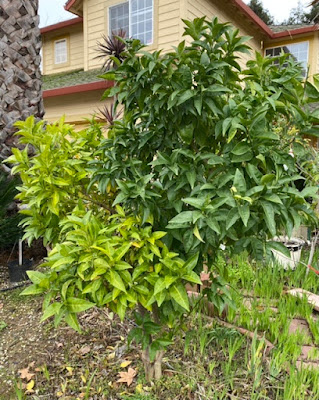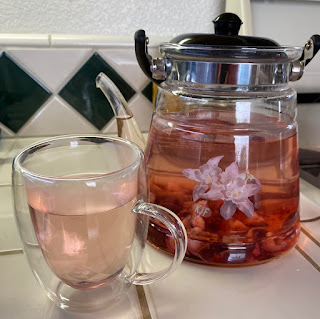As we select plants in nurseries, it is important to inspect the graft joint. This is the place where the scion meets rootstock. Unfortunately, even some commercially produced plants from reputable suppliers may have problems with the graft quality. The performance of such plants will suffer and they may be short lived. In the picture below is my Moro blood orange that I purchased years ago. This tree never grew well. A couple of years ago after noticing sprouts from the rootstock, I grafted the scions from this tree onto the sprouts. The green portion of the tree (on the right) is from my new graft, and the yellowish part is the original tree.
The lower bulbous joint is what the tree came with. There is some structural problem which affects (most likely) the vascular transport in this part of the plant. The higher graft (left) that I made, seems to be more solid structurally and its vascular system supports the flow of nutrients to keep this part of the tree green. In the coming spring, I will remove the original graft and will leave only my grafts to form this tree.Sunday, December 26, 2021
Graft quality matters
Monday, December 13, 2021
Meyer and New Zealand Lemonade lemons
These were picked from pretty young trees, ~2 years in the ground only. I wanted to evaluate NZ Lemonade, and the Meyer lemon seemed to be a good comparison candidate. I heard the NZ lemonade is a low acid one. Meyer is also not the most sour lemon.
In this comparison, Meyer seems to be pretty sour, as NZ Lemonade is almost acidless. It can be eaten like an orange. It is actually very pleasant to eat, my family and I enjoyed it.
White sapotes Vernon, Suebelle, and Lemon Gold
Out of these three cultivars, Lemon Gold tasted the best, followed by Vernon and then Suebelle. The Lemon Gold skin should be peeled as it is bitter. Lemon Gold has the most intense flavor with some caramel in it. It also seemed to be denser, in the texture. Vernon is mild and soft, but also very nice. Suebelle had some notes of not pleasant flavor. The fruit could be past its prime time.
Sunday, December 12, 2021
Shirokolistvennyi satsuma mandarin
I got this cultivar from CCPP only because it had Russian name. "Shirokolistvennyi" means "Wide leafed". The CCPP page says that it originated in the USSR. I wasn't impressed with the flavor last year, when it fruited the first time for me. However, it is different this year. I can taste the exact flavor of the mandarins, which we had in our New Year presents distributed through the Soviet schools in the 1970s (sponsored by the parents). Those who grew there would know what I'm talking about, a mixed bag of candies, walnuts and a couple of mandarins. Unfortunately, no photos of those bags are online, and if I would manage to find any, they would be black and white. Below are mine from today's tasting. The flavor is very nice, but the membranes are pretty hard now. Maybe I should be tasting them earlier in the season. I only had a few fruits from the graft on my Algerian Clementine.
Sunday, November 28, 2021
Tasting persimmons in November 2021
Sunday, November 14, 2021
Cherimoya selection experiment in Vacaville, open ground.
Back in the spring of 2015 I started with 150 cherimoya seedlings in 1 gallon bags. Ninety one plants survived their first summer. About half were up-potted to 5 G pots to go into their first winter. The remaining plants were left in 1 gallon bags.
A couple dozens survivors were planted in ground (by the building wall) in the following spring (2016). More trees died in the following years. Now there are only one strong vigorous tree that bloomed and fruited in 2021. The tree experienced the range of temperatures between 23F - 114F. It grows by the Southern wall and does have some protection from the building.
The first fruit was produced in fall of 2021 without hand pollination. There is another small fruit developing on the tree. The ripe fruit was very pleasant in flavor and sweet, medium in size. I collected all seeds and started germinating them.
I plan to start propagating this tree in spring of 2022.Friday, November 12, 2021
Tagan II feijoa
Now on November 12, I still do not see Tagan II forming gel in the middle of the fruits. It might be specific to this cultivar. My tree fruits the first time ever, and the fruits might develop in a different way in the following years.
The fruit form is unusual, irregular with depressed bottom. The flavor is sweet - sour, well balanced but gritty. The ripening period seems to be late. The skin is tough.
Check our sales site if we have the cuttings available reallygoodplants.com
Sunday, November 7, 2021
A tasting of ten white sapote cultivars
These white sapote fruits were collected from a friend’s orchard on November 6 and tasted on November 7, 2021.
Friday, November 5, 2021
Early White Sapote cultivars
This year, my earliest fruiting cultivar was Redland, I picked two fruits on October 4. I greatly disliked Redland fruits. They have some very unpleasant medicinal flavor. I tasted the same flavor in the fruits collected from a friend's tree a couple of weeks later.
On October 30, I harvested a few fruits of Delta Gold (earlier known as Harvey B3, picture below). These turned out to be excellent fruits. They have a very pleasant intense creamy caramel flavor with thick, but not bitter skin.
On November 4 and 5, I harvested more of Delta Gold and four additional cultivars, see the pictures and descriptions below. These five cultivars are all good to excellent and definitely worth growing. I don't want to give exact scores as these would be based on a few fruits from single trees or grafts.
VernonLemon Gold
The skin is bitter. More intense than Vernon. Sweet caramel with a hint of lemon.
False Suebelle
The skin is not bitter. Very soft sweet melting flesh with a hint of acidity.
Sunday, October 31, 2021
Gilroy Mall feijoas
Back in December of 2016, I tasted feijoa fruits from the plants at Gilroy Mall. A couple of bushes were still abundantly producing tasty fruits.
Two photos below are from December 10, 2016,
I collected the scions from these in the following spring, grafted onto seedlings and planted them in ground in Vacaville. I named them Gilroy Corner and Gilroy End. These year I have fruits on both plants and they just started dropping the fruits on October 30.
The tasting is from October 31, 2021.Saturday, October 23, 2021
Feijoa tasting on October 23, 2021
Sunday, October 17, 2021
Feijoa tasting on October 17, 2021
Flavia - Good flavor, low acid, gritty, soft flesh
8 Ball - Juice, good flavor, some grit, may need more time on the tree
Triumph - Low acid, dense flesh, gritty
Apollo - Lots of jelly, sweet, low acid, juicy, low grit, nice flavor
Abbadabba - Not fully ready, low flavor, low sugar, low acid, high grit
White Goose - Very good, sweet-sour, soft flesh, no grit
Edenvale Late - Excellent flavor, sweet-sour, gritty, may need more time to ripen
Chesterwoody - Very sweet, dense flesh, no grit, overripe by now (this is my earliest cultivar)
Tagan II - Excellent flavor, sweet-sour, creamy flesh with little grit
Friday, October 15, 2021
Den's Choice Feijoa
Den's Choice feijoa just started dropping fruits this year on October 15. This is one of the best mid season cultivars. The flesh is smooth, lots of jelly, sweet with some acidity and very pleasant flavor.
Thursday, October 14, 2021
Purple guava makes excellent tea
Purple guava, Psidium myrtoides makes small purple fruits with large seeds and low sugar content. I almost removed the tree as I didn't particulary liked fresh fruits. They taste very healthy and have a high amount of flavonoids, but not enjoyable to eat.
The fruits are usually formed in small clusters.
Before digging the tree out, I decided to make a tea out of the fruits, and this saved the tree. The tea flavor reminded me the black currant fruit flavor. They should share similar compounds responsible for this flavor. Purple guava is definitely worth growing for making drinks.
Cuttings Sale in June of 2025
This post describes the greenwood cuttings sale on reallygoodplants.com in June of 2025. The sale will open at 6 PM PST on June 5. All s...























































